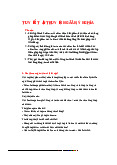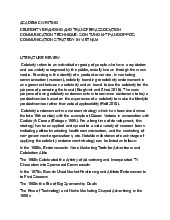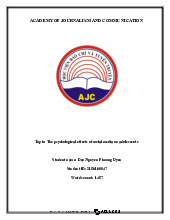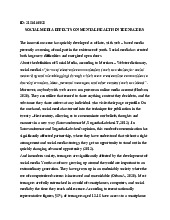








Preview text:
lOMoAR cPSD| 46560390
ACADEMY OF JOURNALISM AND COMMUNICATION
------------------------- Module: QQ56011 ACADEMIC WRITING
Topic: The impact of social media on self-perception
Student name: ĐỖ QUỲNH ANH
Student ID: 2156160001 Words count: 1600 lOMoAR cPSD| 46560390
Hanoi, April 2022
The impact of social media on self-perception
Social media is a phenomenon that has changed the way people interact,
connect, communicate, and even how they see themselves. Through social
networking sites, people share images, videos, their activities and lifestyle. This
trend has sparked a debate about the impact of social media on people’s perception
of themselves. Therefore, the purpose of this essay is to discuss the relationship
between social media use and self-perception. This essay begins by discussing the
negative impact, which includes how social media affects one’s self-esteem,
selfimage and body image. Subsequently, it explores several positive effects of social
media on one’s self-perception.
In Kaplan and Haenlein’s study (2010), social media is a variety of webbased
applications that are built on the platform of Web 2.0, allowing the formation and
circulation of User Generated Content. Regarding self-perception, its theory was first
presented by Bem (1967), stating that attitude statements are inferred through the
observations of an individual’s behavior. There have been several pieces of research
conducted with different approaches to discover the link between social media and
self-perception (Taber & Whittaker, 2018; Gallinari, 2017). Based on the results of
previous research, it can be concluded that exaggerated self-presentation content is
shared daily on social networking sites, especially Facebook, and the impact it has
on individuals may vary depending on how they use social media.
To begin with, social media has had negative effects on people’s
selfperception, especially on their self-esteem, as content with idealized self-image
is often shared among social media users. People's self-esteem has been lowered as
a result of constant and upward comparisons made on social media [ CITATION
Jan17 \l 1033 ]. By making such comparisons between themselves and others, it is lOMoAR cPSD| 46560390
easier for people to evaluate their abilities, attitudes, and personality traits, which, in
turn, has an impact on how they view themselves [ CITATION Gib99 \l 1033 ]. It
has been proven in Chen and Lee’s research (2013) that through social networking
sites, people make more social comparisons, which results in higher psychological
distress and the degradation of their self-esteem. As platforms for social comparison
are continuing to grow as a result of the appearance of various types of social media,
people are not only comparing themselves to someone in the same room, but also to
millions of people all around the world. The two common kinds of comparisons that
people make on social media are downward and upward comparisons. Upward
comparison occurs when people compare themselves to individuals whom they feel
better and more superior than them while downward comparison takes place when
people make comparisons with those who are less fortunate (Wills, 1981; Wood,
1989). An upward comparison may be made for the longing to enhance one’s self-
esteem as they often concentrate on imitating the behavior and attitudes of their
comparison targets in order to improve their current status or skills. However,
upward comparison has been proved to lead to a decrease in people’s self-esteem,
making them feel inferior or have negative judgments of their personal worth [
CITATION Mor70 \l 1033 ]. Comparing ourselves to those who are worse off than
us on social media makes us feel better about our personalities, abilities and
accomplishments. Comparing ourselves to others who are performing better than us,
on the other hand, in most cases makes us feel inferior or incompetent. Aside from
self-esteem, social media is also observed to have negative effects on our perception
of our true selves. By using social media applications, especially Snapchat and
Instagram, it has been increasingly common in recent years for people to edit not
only photographs of nature, but also their own looks. Applications such as Snapchat
or Instagram allow people to apply lenses, photoshop and filters to photographic
content with just a swipe or click, which often alters their physical appearance. While lOMoAR cPSD| 46560390
the sole purpose of these applications is for entertainment, it has been noticed by
physicians that an increasing number of individuals are seeing plastic surgeons
requesting to appear like their filtered photos. In fact, a report in 2018 by Rajanala,
Maymone and Vashi pointed out that filtered pictures blur “the line of reality and
fantasy”, which may even cause body dysmorphic disorder, a mental health disease
in which people get obsessed with unreal flaws in their looks. To review, it is clear
from the findings discussed above that the degradation in one’s self-esteem and self-
image rises simultaneously with social media usage.
Furthermore, based on existing studies and research, when examining the
effects of social media on self-perception, it is also necessary to include the
relationship between the social network and body image. The act of browsing
through posts on a regular basis, especially those that provoke negative emotions or
glorify a specific body type, might have a negative effect on one’s body image. One
of the most common ways social media can harm people’s body image is by
displaying photos of idealized body types, resulting in upward comparison between
their body and others. Unrealistic expectations and comparisons of how one’s body
should appear can result from negative body images displayed on social media. The
link between social media use and body image has been studied in several research.
In 2014, Tiggemann and Slater’s study on pre-teenagers pointed out that social media
users, especially Facebook users, express stronger desire for thinness, body
objectification and comparison than non-social media users. Other correlational
research on high school students and undergraduate students also shows that higher
levels of body dissatisfaction and a desire to be thin have also been linked to
spending more time on social media (Vandenbosch & Eggermont, 2012; Tiggemann
& Slater, 2013; Fardouly & Vartanian, 2015). Because social media is filled with
people presenting themselves at their finest, it can be hard to avoid seeing content
that make people feel bad and unconfident about themselves. Moreover, the large lOMoAR cPSD| 46560390
amount of photographic content posted on social media sites per day allows users to
make appearance-related comparisons regularly, causing negative body image.
Another way social media can affect one’s body image is fitspiration and
thinspiration, also called “fitspo” and “thinspo” - the terms that are used to promote
thinness and fitness. Thinspiration posts contain photos of extremely underweight
and skinny body figures, while fitspiration posts motivate individuals to adopt
healthy lifestyles by encouraging diet and exercise [ CITATION Alb18 \l 1066 ].
Similar to Boepple & Thompson’s research (2016), Alberga, Withnell & von
Ranson’s study in 2018 showed that thinspiration posts encouraged explicit weight
loss, objectifying photographic content and references to eating disorders and mental
illness more frequently than fitspiration posts. Through previous studies, it can be
concluded that men and women who are exposed daily to fitspiration and
thinspiration content may suffer from body dissatisfaction and poor emotional
functioning. While the majority of studies on the effects of social media on body
image focus on women, there are several studies indicating that men have similar
impacts. It can be seen that men’s social media usage has increased almost as
frequently as women’s, owing to the pervasiveness of social media in everyday
life[CITATION APe15 \l 1033 ], and they are also exposed to trends that promote
strong and muscular body figures. Research conducted by Fox & Rooney (2015)
showed that there is a relationship between social media usage and body image
concerns in men. Furthermore, Gültzow, et al.’s study in 2020 showed that posts of
muscular and low body fat white men were most commonly displayed on Instagram,
which contributes to body comparisons and dissatisfaction among men. In summary,
it may seem that the magnitude of the relationship between body objectification and
body dissatisfaction was stronger in women, but no gender difference was found in
the relationship between social media use and body image concerns. lOMoAR cPSD| 46560390
Although the negative effects of social media on self-perception have been
extensively documented, there may also exist some positive effects. Firstly,
individuals can use social media to connect with others and build a body-accepting
community. There have been many communities founded with the purpose to
promote healthy habits rather than extreme weight loss or diet, helping people to
understand their body and more importantly, providing support to individuals.
Secondly, more and more brands are conducting body-positivity campaigns with the
aim to inspire individuals to battle social stigma and stereotypical beauty standards.
Advertisements such as “Stop the beauty test” by Dove, “Love every inch” by Plum
Body, “I am size happy” by Diya Women, etc. have encouraged people to start to
appreciate and embrace their authentic selves and set aside society norms or
unrealistic beauty standards on social media [ CITATION Sam21 \l 1066 ]. Finally,
the social network can also help users who are focused on close friends enhance their
self-esteem. By complementing previous studies on how people present themselves
to friends versus strangers, Wilcox and Stephen’s research in 2013 has discovered
that when focusing on pictures shown to close friends on social media, people
experience higher self-esteem. Social media can bring plenty of positive effects on
our self-perception, but it is important that we keep a healthy approach and usage.
As stated by DiMaggio, et al., (2001) and Laplante (2022), how social media affect
one’s self-image mainly depends on their usage and how much comparing they do on social networking sites.
Social media has been powerful in shaping our self-perception. Self-esteem,
self-presentation, self-image and body image are just a few of the important areas
that have been significantly impacted by the vast and growing social media. While
it is undeniable that social media may enhance people’s self-esteem and selfimage,
it should still be used smartly, properly and responsibly, because the negative impacts lOMoAR cPSD| 46560390
it might bring are harmful and detrimental to our perception of the world and ourselves. References
Alberga, A. S., Withnell, S. J., & von Ranson, K. M. (2018). Fitspiration and
thinspiration: a comparison across three social networking sites. Journal of
Eating Disorders, 6(1), 1-10.
Bem, D. J. (1967). Self-perception: An alternative interpretation of cognitive
dissonance phenomena. Psychological review, 74(3), 183-185.
Bem, D. J. (1972). Self-perception theory. Advances in experimental social psychology, 6, 1-5.
Bisht, S. (2021, July 13). socialsamosa.com. Retrieved from Body positivity
campaigns that encouraged going beyond superficial body standards:
https://www.socialsamosa.com/2021/07/body-positivity-campaigns-india/
Boepple, L., & Thompson, J. K. (2016). A content analytic comparison of
fitspiration and thinspiration websites. International Journal of Eating Disorders, 49(1), 98-101.
Brazier, Y. (2020, October 11). What is body image? Retrieved from
MedicalNewsToday: https://www.medicalnewstoday.com/articles/249190
Carpenter, C. J. (2012). Narcissism on Facebook: self-promotional and anti-social
behavior. Personality and Individual Differences, 52, 482-486.
Chen, W., & Lee, K. H. (2013). Sharing, liking, commenting, and distressed? The
pathway between Facebook interaction and psychological distress.
Cyberpsychology, behavior, and social networking, 16(10), 728-734.
Correa, T., Hinsley, A. W., & De Zuniga, H. G. (2010). Who interacts on the Web?:
The intersection of users’ personality and social media use. Computers in
human behavior, 26(2), 247-253.
DiMaggio, P., Hargittai, E., Neuman, W. R., & Robinson, J. P. (2001). Social
implications of the Internet. Annual review of sociology, 27(1), 307-336.
Fardouly, J., & Vartanian, L. R. (2015). Negative comparisons about one's
appearance mediate the relationship between Facebook usage and body
image concerns. Body image, 12, 82-88. lOMoAR cPSD| 46560390
Finn, S. (1997). Origins of media exposure: Linking personality traits to TV, radio,
print, and film use. Communication research, 24(5), 507-529.
Gallinari, E. (2017). “Likes” for Self-Love? The Effects of Social Media on
SelfPerception. Undergraduate Review, 100-105.
Gibbons, F. X., & Buunk, B. P. (1999). Individual differences in social comparison:
Development of a scale of social comparison orientation. Journal of
Personality and Social Psychology, 76(1), 129-142.
Has social media changed the way we see ourselves? (2020, February 6).
Retrieved from debatingeurope.eu:
https://www.debatingeurope.eu/2020/02/06/has-social-media-changed-
theway-we-see-ourselves/#.Yka8tS8RpQI
Irons, W. (1996). In our own self image. Skeptic, 4(2), 50-52.
Jan, M., Soomro, S., & Ahmad, N. (2017). Impact of social media on self-esteem.
European Scientific Journal, 13(23), 329-341.
Jiang, S., & Ngien, A. (2020). The effects of Instagram use, social comparison, and
self-esteem on social anxiety: A survey study in Singapore. Social Media+
Society, 6(2), 2056305120912488.
Kim, H. K., & Davis, K. E. (2009). Toward a comprehensive theory of problematic
Internet use: Evaluating the role of self-esteem, anxiety, flow, and the
selfrated importance of Internet activities. Computers in Human Behavior, 25(2), 490-500.
Laplante, S. (2022, January 9). How social media can crush your self-esteem .
Retrieved from The Conversation: https://theconversation.com/how-
socialmedia-can-crush-your-self-esteem-174009
Morse, S., & Gergen, K. J. (1970). Social comparison, self-consistency, and the
concept of self. Journal of personality and social psychology, 16(1), 148150.
Perrin, A. (2015). Social media usage. Washington, DC: Pew Research Center.
Rajanala, S., Maymone, M. B., & Vashi, N. A. (2018). 2018. Selfies—living in the
era of filtered photographs, 20(6), 443-444.
Taber, L., & Whittaker, S. (2018). Personality depends on the medium: differences
in self-perception on Snapchat, Facebook and offline. Proceedings of the
2018 CHI Conference on Human Factors in Computing Systems, 1-13.
Tiggemann, M., & Slater, A. (2013). NetGirls: The Internet, Facebook, and body
image concern in adolescent girls. International Journal of Eating Disorder, 46(6), 630-633. lOMoAR cPSD| 46560390
Tiggemann, M., & Slater, A. (2014). Nettweens: The internet and body image
concerns in preteenage girls. The Journal of Early Adolescence, 34(5), 606620.
Vandenbosch, L., & Eggermont, S. (2012). Understanding sexual objectification: A
comprehensive approach toward media exposure and girls' internalization of
beauty ideals, self-objectification, and body surveillance. Journal of
Communication, 65(2), 869-887.
Wang, D. (2017). A study of the relationship between narcissism, extraversion,
drive for entertainment, and narcissistic behavior on social networking sites.
Computers in Human Behavior, 66, 138-148.
Wills, T. A. (1981). Downward comparison principles in social psychology.
Psychological Bulletin, 90, 245-271.
Wood, J. V. (1989). Theory and research concerning social comparison of personal
attributes. Psychological Bulletin(106), 231-248.



